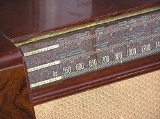
of signals through free space by modulation of electromagnetic waves
with frequencies
below those of visible light. Electromagnetic radiation travels
by means of oscillating electromagnetic field
s that pass through the air and the vacuum
of space. Information is carried by systematically changing (modulating
) some property of the radiated waves, such as amplitude
, frequency
, phase
, or pulse width. When radio waves pass an electrical conductor, the oscillating fields induce an alternating current in the conductor.
1893 Nikola Tesla gives the first public demonstration of radio in St. Louis, Missouri.
1896 A. A. Popov makes the first radio signal transmission in history.
1896 Guglielmo Marconi applies for a patent for his newest invention: the radio.
1897 Italian scientist Guglielmo Marconi obtains a patent for radio in London.
1901 Guglielmo Marconi receives the first transatlantic radio signal at Signal Hill in St John's, Newfoundland.
1906 Radio: Reginald Fessenden transmits the first radio broadcast; consisting of a poetry reading, a violin solo, and a speech.
1908 A long-distance radio message is sent from the Eiffel Tower for the first time.
1920 Montreal, Quebec radio station XWA broadcasts the first regularly scheduled radio programming in North America.
1920 Telecommunications: the first transatlantic two-way radio broadcast takes place.
1920 The first commercial radio station, 8MK (WWJ), begins operations in Detroit, Michigan.

